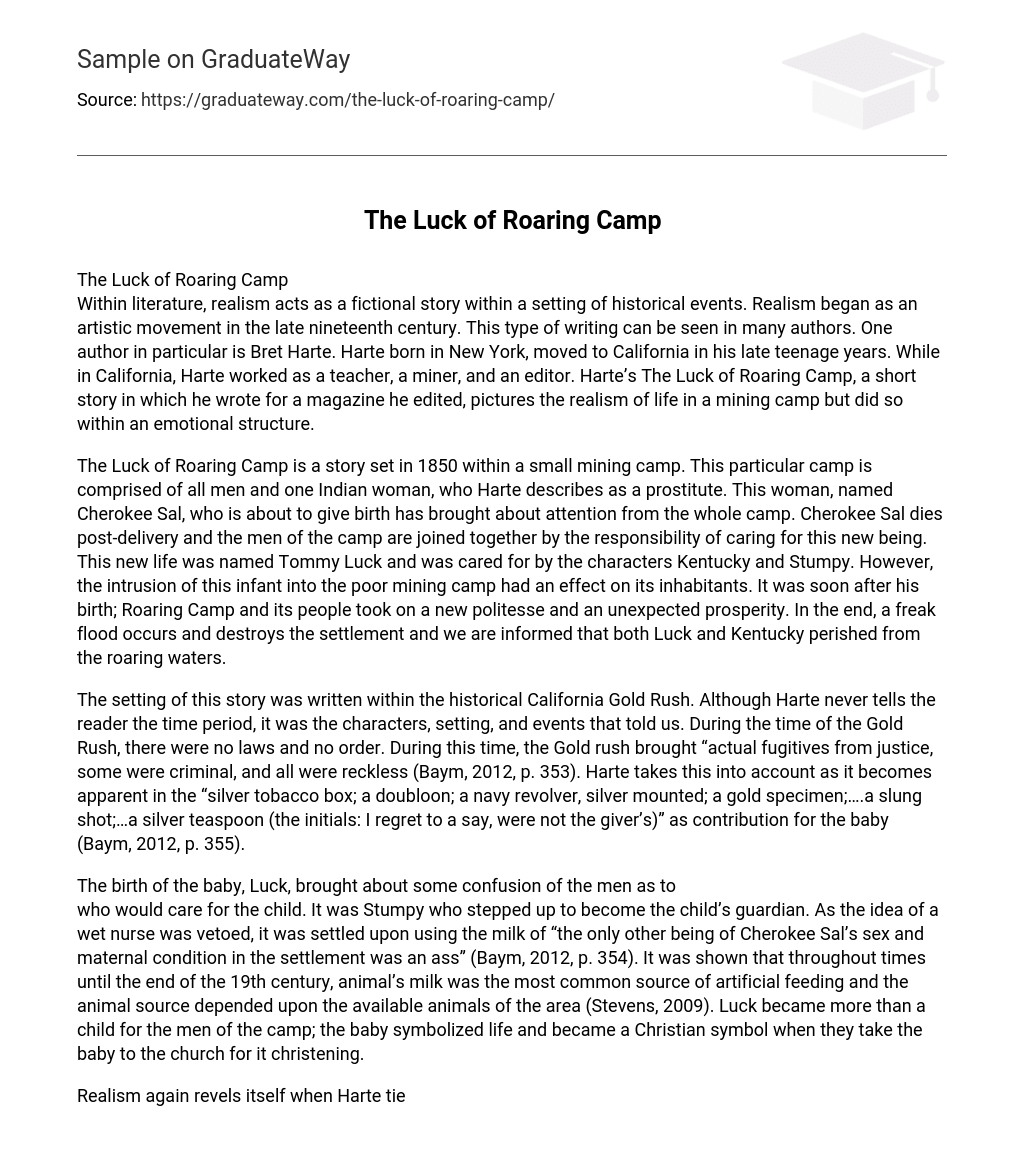Within literature, realism acts as a fictional story within a setting of historical events. Realism began as an artistic movement in the late nineteenth century. This type of writing can be seen in many authors. One author in particular is Bret Harte. Harte born in New York, moved to California in his late teenage years. While in California, Harte worked as a teacher, a miner, and an editor. Harte’s The Luck of Roaring Camp, a short story in which he wrote for a magazine he edited, pictures the realism of life in a mining camp but did so within an emotional structure.
The Luck of Roaring Camp is a story set in 1850 within a small mining camp. This particular camp is comprised of all men and one Indian woman, who Harte describes as a prostitute. This woman, named Cherokee Sal, who is about to give birth has brought about attention from the whole camp. Cherokee Sal dies post-delivery and the men of the camp are joined together by the responsibility of caring for this new being. This new life was named Tommy Luck and was cared for by the characters Kentucky and Stumpy.
However, the intrusion of this infant into the poor mining camp had an effect on its inhabitants. It was soon after his birth; Roaring Camp and its people took on a new politesse and an unexpected prosperity. In the end, a freak flood occurs and destroys the settlement and we are informed that both Luck and Kentucky perished from the roaring waters.
The setting of this story was written within the historical California Gold Rush. Although Harte never tells the reader the time period, it was the characters, setting, and events that told us. During the time of the Gold Rush, there were no laws and no order. During this time, the Gold rush brought “actual fugitives from justice, some were criminal, and all were reckless (Baym, 2012, p. 353). Harte takes this into account as it becomes apparent in the “silver tobacco box; a doubloon; a navy revolver, silver mounted; a gold specimen;….a slung shot;…a silver teaspoon (the initials: I regret to a say, were not the giver’s)” as contribution for the baby (Baym, 2012, p. 355).
The birth of the baby, Luck, brought about some confusion of the men as to who would care for the child. It was Stumpy who stepped up to become the child’s guardian. As the idea of a wet nurse was vetoed, it was settled upon using the milk of “the only other being of Cherokee Sal’s sex and maternal condition in the settlement was an ass” (Baym, 2012, p. 354).
It was shown that throughout times until the end of the 19th century, animal’s milk was the most common source of artificial feeding and the animal source depended upon the available animals of the area (Stevens, 2009). Luck became more than a child for the men of the camp; the baby symbolized life and became a Christian symbol when they take the baby to the church for it christening.
Realism again revels itself when Harte ties in the death factor that many experienced during the time of the Gold Rush. Harte describes the mining camp as “deaths were by no means uncommon in Roaring Camp” (Baym, 2012, p. 353). Hygiene was also something left to be desired during this time. Harte embellishes on this as Kentucky refers to “all garments as a second cuticle” (Baym, 2012, p. 357).
As a reader of Bret Harte, one may notice his stories hold some realism to their every word. Realism, within literature, is nothing more than the truth intertwined in fiction. It was the characters in The Luck of Roaring Camp that Harte compounded as good and evil as in life, thus approximating the truth, and avoiding the error of the cartoon.
References
- Baym, N. & Levine, R. (2012). The Norton Anthology of American Literature (8th edition vol. C). New York, NY: W.W Norton & Company Inc
- Stevens, E. (2009). A history of infant feeding. The Journal of Parinatal Education, 18(2), 32-39. doi: 10.1624/105812409X426314





